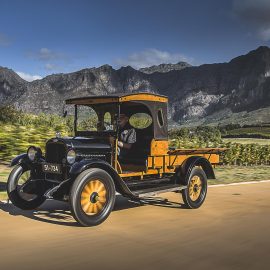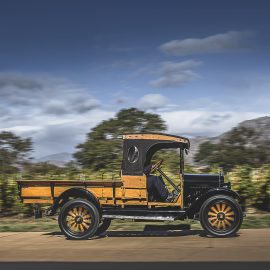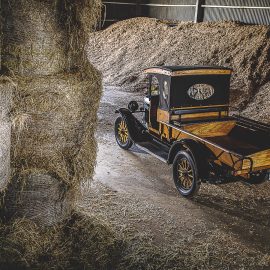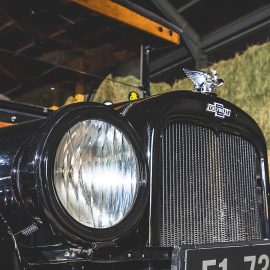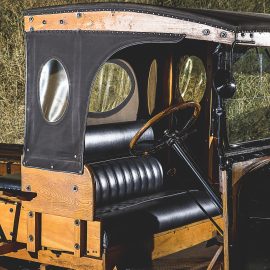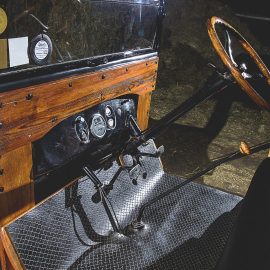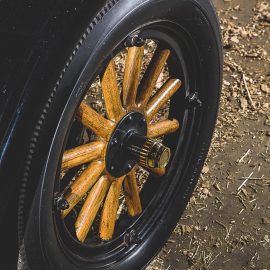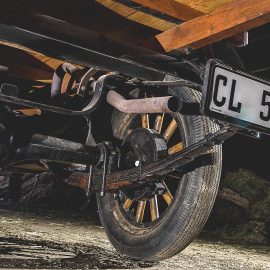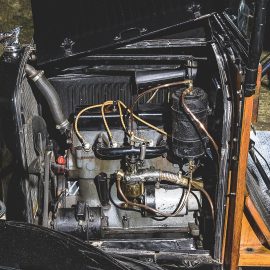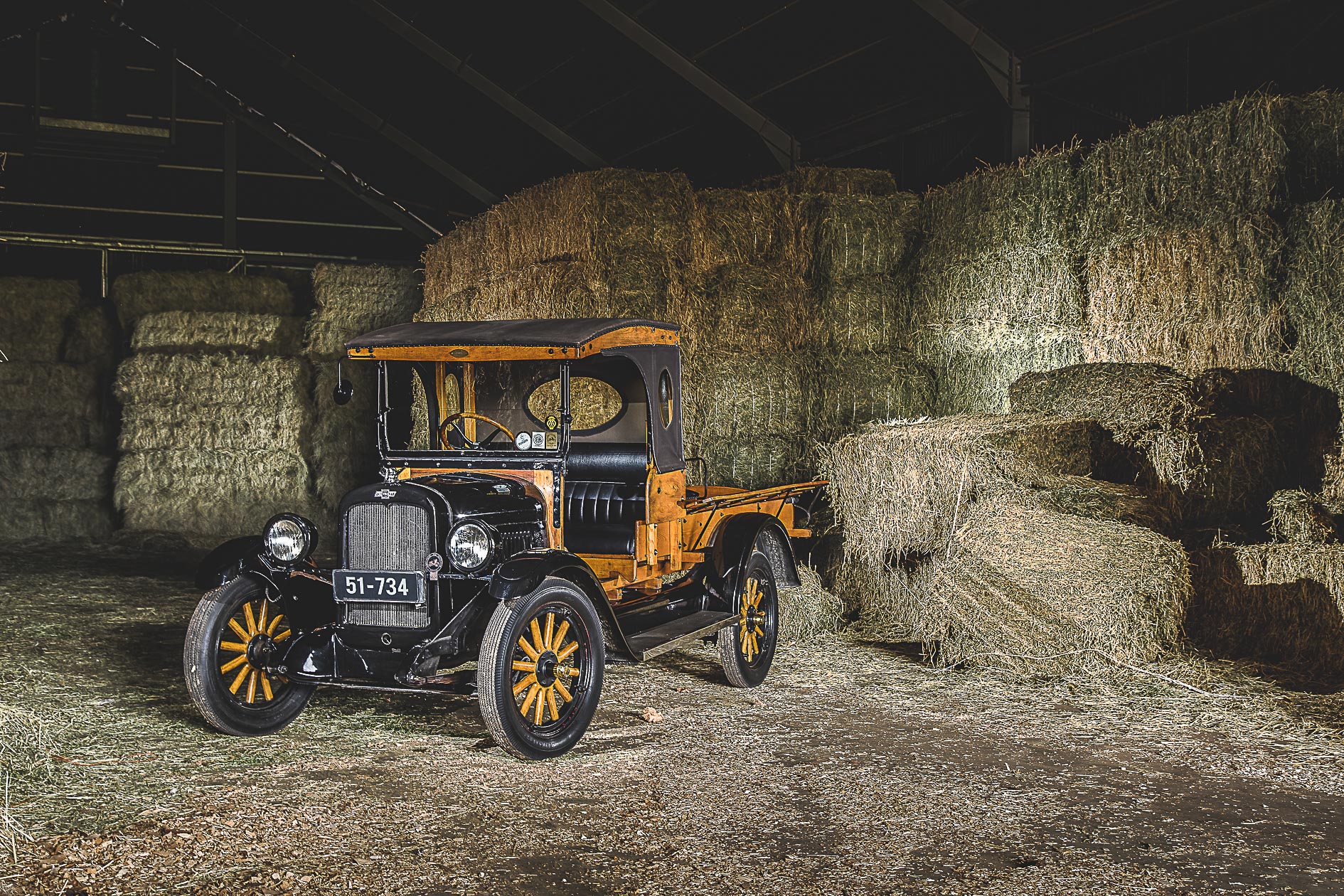
28 Nov Collection In Action: 1926 Chevrolet Pick-up
Light commercial vehicles have played vital roles in the development of countries around the world, not least on the African continent where South Africa stands proud amongst its fellow nations. Mike Monk drives a superb example of an early Chev bakkie, the likes of which helped to set the trend…
Pick-ups in particular have been perennial workhorses in helping to build and expand South Africa’s resources, both human and material. We even have our own name for them – bakkies. Early examples were generally very basic in concept and construction, bearing only a windscreen-forward resemblance to the passenger vehicle they were based upon. But chassis were relatively robust items and whatever configuration of load bed they carried, generally withstood use and abuse over predominantly poor roads far beyond their original design intent.
Chevy pick-ups have historically met with high favour among buyers of light commercial vehicles whether for business or private use. In fact, Chevrolet was one of the early manufacturers to establish roots in SA, entering the market way back in 1913 with imported vehicles before a limited amount of local production began in 1925 in Port Elizabeth. It was at this time that the bakkie featured here first turned a wheel in anger, and although now a showpiece at FMM, it still has that solid, dependable nature that attracted hundreds of buyers almost a century ago. But back to the beginning…
It is believed that Chevrolet built a few Model 490 pick-ups in 1916 primarily for its own use, but some were converted into ambulances and shipped to France. The first production model was built in November 1918 and left the Flint, Michigan factory in December. In its first year, the company made less than 1 000 examples in both half- and one-ton configurations, but the following year was a success when more than 8 000 were built. Two four-cylinder models were offered, both as a chassis with a metal cowl, bonnet and front fenders. Buyers generally added their own wooden cab and cargo box or a panel van body.
The half-ton model was actually a Chevrolet 490 car without its body, but with beefed-up rear springs, and was priced at $595. The one-ton pick-up, called the Model T for ‘truck,’ was priced at $1 125, again without a body. Although it was based on the FA-series car, the pick-up was built on a truck frame and was both longer and stronger than the half-tonner. A 37 hp (27,5 kW) engine boosted the pick-up’s power and load capacity, but a governor limited its top speed to 25 mph (40 km/h). The lineage of Chevrolet pick-ups had begun.
In the early-1920s, Chevrolet installed a variety of outside-sourced bodies on its chassis-cab pick-ups in plants despite sales declining in 1921 as part of an overall economic decline. For instance, in 1922, the company offered a ¾-ton Model G at $650 for the chassis-cowl without the rest of the body. In January 1923 a new model was introduced based on a facelifted four-cylinder 490 chassis. As well as being designated Type B the model carried the Superior name as well.
The Type B Superior was powered by a 171 ci (2802cc) inline-four with a single-choke Carter carburettor and produced 19 kW at 2 000 r/min. Designed by Arthur Mason and first introduced in 1913, the block was cast iron and the crank ran in three main bearings fed by splash lubrication. The engine featured exposed pushrod-actuated valves in a detachable crossflow cylinder head, which Chevrolet referred to as a ‘valve-in-head’ design. This drew considerable publicity in a time when most rivals’ engines were flatheads. The engine was mated with a three-speed sliding transmission with a cone clutch and shaft drive. Wood-spoke wheels were standard and external contracting brakes acted upon the rear wheels. Wheelbase was 103 inches (2 616 mm).
In 1924, Danish-born William S Knudson (Henry Ford’s former production manager) took over as president and general manager of Chevrolet. To digress a little, he soon ordered the recall of the disastrous ‘copper-cooled’ Chevrolets. Charles Kettering’s singular vision of a copper-cooled engine seemed to fulfil GM’s quest for a low-cost, lightweight, high-performance engine with fewer parts and easy maintenance. While the new air-cooled engine had originally been intended for Oakland, scheduling pressures caused it to be released to Chevrolet instead. From its debut at the New York Motor Show in January 1923, the 135 ci (2212cc) engine, which developed 15 kW at 1 750 r/min, met with public indifference. The engine’s realisation fell short of its concept, and uneven air distribution throughout the engine continued to be a problem.
So, on 1 August 1923 the 1924-model-year Superior was introduced, pioneering a trend towards annual model-year updates within GM. Also dubbed as the Series F, the model was virtually unchanged save for a switch to slightly bigger ‘non skid’ tyres. In January 1925 the next iteration appeared, labelled Series K, which was fronted by a new radiator design. Construction of the engine block was changed to encompass a new crank and con-rods. A disc clutch was also adopted. And, at last, the ‘Chevrolet hum’ caused by the bevel-gear rear axle inherited from the 490 was eliminated thanks to a new banjo-type rear axle mounted in a carrier connected with a torque tube. An all-steel cab was also offered and a panel van was added to the range. As an aside, this was the year that Henry Ford introduced the first Model T pick-up.
In keeping with tradition, when the 1926 Superior appeared in the middle of the year, it was coded as the Series V. It was essentially the same as the Series K but boasted a belt-driven generator and different tyres (again). Visually, a tie-bar connecting the headlamps was an obvious styling difference.
The FMM car is a 1926 model and from the shiny wooden dashboard rearwards has an open-sided cockpit with a fabric screen enclosing the rear of the cab. Behind, there is a bespoke flat-bed body with extended sides made also from wood with the same marine varnish finish that glistens in the sunlight. On each side, metal running boards connect the mudguards that cover wooden artillery wheels – the overall effect is certainly attractive.
The wood-rim – what else? – steering wheel sits atop the long steering column, which sprouts from the floor between the brake and clutch pedals, with the small, central accelerator lying beneath them. A stout handbrake is a long reach away but the spindly gear lever falls readily to hand, topped by, you guessed it, a small wooded knob…
The four-pot fires up with ease and the Chevy pick-up, bakkie, truck, ute – you name it, endearing terms all – pulls away with no fuss. First gear in the typically American three-speed manual gearbox proves to be load-lugging low, while second is the workhorse ratio, allowing the Chevy to roll from walking pace to near cruising speed without hiccup. Top is almost an overdrive and, certainly when unladen, maintains momentum without labouring. The bench seat is surprisingly comfy; in fact, the whole driving position is relaxing. The ride is not as harsh as I had expected and the steering, too, is nicely weighted. It is a classic example of early American ‘simple yet strong’ auto technology and its robust nature was instrumental in Chevrolet’s sales success.
Chevrolet pulled ahead of Ford in terms of sales in 1927 with the best-selling truck in America and so the long-running Ford versus Chevrolet rivalry began. For its last year of manufacture – 1928 – the Mason four-cylinder gained a revised carburettor, a higher compression ratio, aluminium pistons and larger valves that helped raise maximum power to 26 kW at 2 200 r/min. In 1929 Chevrolet produced its half-millionth truck but the Wall Street Crash happened in October of that year and devastated America’s economy.
Superior in name, practical in nature, the Roaring ’20s pick-ups cemented the foundation for Chevrolet’s now century-old pick-up legacy that had been created by the 490 – one of the bow-tie brand’s unsung heroes.
The 1926 Chevrolet ‘woody’ pick-up is currently on view in Hall B.




